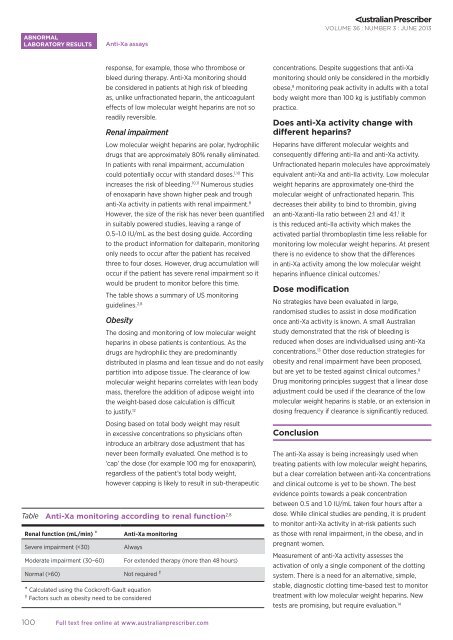download the full PDF issue - Australian Prescriber
download the full PDF issue - Australian Prescriber
download the full PDF issue - Australian Prescriber
You also want an ePaper? Increase the reach of your titles
YUMPU automatically turns print PDFs into web optimized ePapers that Google loves.
ABNORMAL<br />
LABORATORY RESULTS<br />
Anti-Xa assays<br />
VOLUME 36 : NUMBER 3 : JUNE 2013<br />
response, for example, those who thrombose or<br />
bleed during <strong>the</strong>rapy. Anti-Xa monitoring should<br />
be considered in patients at high risk of bleeding<br />
as, unlike unfractionated heparin, <strong>the</strong> anticoagulant<br />
effects of low molecular weight heparins are not so<br />
readily reversible.<br />
Renal impairment<br />
Low molecular weight heparins are polar, hydrophilic<br />
drugs that are approximately 80% renally eliminated.<br />
In patients with renal impairment, accumulation<br />
could potentially occur with standard doses. 1,10 This<br />
increases <strong>the</strong> risk of bleeding. 10,11 Numerous studies<br />
of enoxaparin have shown higher peak and trough<br />
anti-Xa activity in patients with renal impairment. 8<br />
However, <strong>the</strong> size of <strong>the</strong> risk has never been quantified<br />
in suitably powered studies, leaving a range of<br />
0.5–1.0 IU/mL as <strong>the</strong> best dosing guide. According<br />
to <strong>the</strong> product information for dalteparin, monitoring<br />
only needs to occur after <strong>the</strong> patient has received<br />
three to four doses. However, drug accumulation will<br />
occur if <strong>the</strong> patient has severe renal impairment so it<br />
would be prudent to monitor before this time.<br />
The table shows a summary of US monitoring<br />
guidelines. 2,8<br />
Obesity<br />
The dosing and monitoring of low molecular weight<br />
heparins in obese patients is contentious. As <strong>the</strong><br />
drugs are hydrophilic <strong>the</strong>y are predominantly<br />
distributed in plasma and lean t<strong>issue</strong> and do not easily<br />
partition into adipose t<strong>issue</strong>. The clearance of low<br />
molecular weight heparins correlates with lean body<br />
mass, <strong>the</strong>refore <strong>the</strong> addition of adipose weight into<br />
<strong>the</strong> weight-based dose calculation is difficult<br />
to justify. 12<br />
Dosing based on total body weight may result<br />
in excessive concentrations so physicians often<br />
introduce an arbitrary dose adjustment that has<br />
never been formally evaluated. One method is to<br />
‘cap’ <strong>the</strong> dose (for example 100 mg for enoxaparin),<br />
regardless of <strong>the</strong> patient’s total body weight,<br />
however capping is likely to result in sub-<strong>the</strong>rapeutic<br />
Table Anti-Xa monitoring according to renal function 2,8<br />
Renal function (mL/min) *<br />
Severe impairment (60) Not required †<br />
* Calculated using <strong>the</strong> Cockcroft-Gault equation<br />
† Factors such as obesity need to be considered<br />
For extended <strong>the</strong>rapy (more than 48 hours)<br />
concentrations. Despite suggestions that anti-Xa<br />
monitoring should only be considered in <strong>the</strong> morbidly<br />
obese, 8 monitoring peak activity in adults with a total<br />
body weight more than 100 kg is justifiably common<br />
practice.<br />
Does anti-Xa activity change with<br />
different heparins<br />
Heparins have different molecular weights and<br />
consequently differing anti-IIa and anti-Xa activity.<br />
Unfractionated heparin molecules have approximately<br />
equivalent anti-Xa and anti-IIa activity. Low molecular<br />
weight heparins are approximately one-third <strong>the</strong><br />
molecular weight of unfractionated heparin. This<br />
decreases <strong>the</strong>ir ability to bind to thrombin, giving<br />
an anti-Xa:anti-IIa ratio between 2:1 and 4:1. 1 It<br />
is this reduced anti-IIa activity which makes <strong>the</strong><br />
activated partial thromboplastin time less reliable for<br />
monitoring low molecular weight heparins. At present<br />
<strong>the</strong>re is no evidence to show that <strong>the</strong> differences<br />
in anti-Xa activity among <strong>the</strong> low molecular weight<br />
heparins influence clinical outcomes. 1<br />
Dose modification<br />
No strategies have been evaluated in large,<br />
randomised studies to assist in dose modification<br />
once anti-Xa activity is known. A small <strong>Australian</strong><br />
study demonstrated that <strong>the</strong> risk of bleeding is<br />
reduced when doses are individualised using anti-Xa<br />
concentrations. 13 O<strong>the</strong>r dose reduction strategies for<br />
obesity and renal impairment have been proposed,<br />
but are yet to be tested against clinical outcomes. 8<br />
Drug monitoring principles suggest that a linear dose<br />
adjustment could be used if <strong>the</strong> clearance of <strong>the</strong> low<br />
molecular weight heparins is stable, or an extension in<br />
dosing frequency if clearance is significantly reduced.<br />
Conclusion<br />
The anti-Xa assay is being increasingly used when<br />
treating patients with low molecular weight heparins,<br />
but a clear correlation between anti-Xa concentrations<br />
and clinical outcome is yet to be shown. The best<br />
evidence points towards a peak concentration<br />
between 0.5 and 1.0 IU/mL taken four hours after a<br />
dose. While clinical studies are pending, it is prudent<br />
to monitor anti-Xa activity in at-risk patients such<br />
as those with renal impairment, in <strong>the</strong> obese, and in<br />
pregnant women.<br />
Measurement of anti-Xa activity assesses <strong>the</strong><br />
activation of only a single component of <strong>the</strong> clotting<br />
system. There is a need for an alternative, simple,<br />
stable, diagnostic clotting time-based test to monitor<br />
treatment with low molecular weight heparins. New<br />
tests are promising, but require evaluation. 14<br />
100 Full text free online at www.australianprescriber.com
















